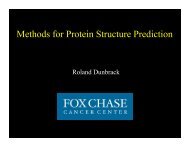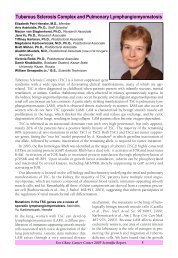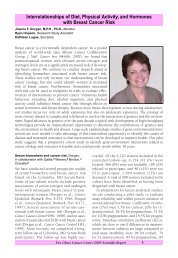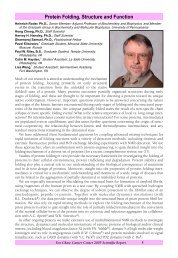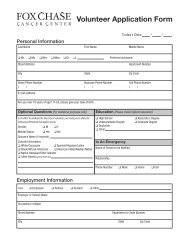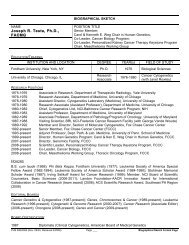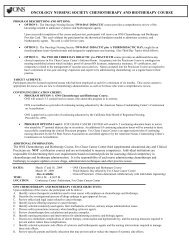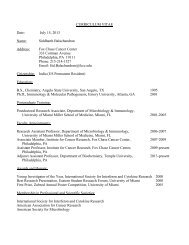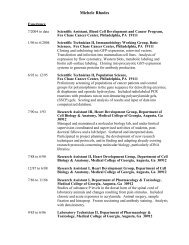Double Trouble:
Double Trouble:
Double Trouble:
Create successful ePaper yourself
Turn your PDF publications into a flip-book with our unique Google optimized e-Paper software.
<strong>Double</strong> <strong>Trouble</strong>:<br />
Consequences of Immune Cell<br />
Mis-Recruitment following Multiple<br />
Viral Challenges<br />
Christine Matullo<br />
Glenn Rall<br />
Research and Technology Symposium<br />
20 May 2008
Overview<br />
Question<br />
Model<br />
Outcomes<br />
Significance<br />
Opportunity<br />
Lunch
Can peripheral viral infections-or<br />
the immune responses to those infections-contribute<br />
to CNS disease?<br />
CNS diseases of<br />
unknown etiology<br />
-Multiple sclerosis<br />
-Autism<br />
-Alzheimer’s<br />
-Lou Gehrig’s disease/ALS<br />
-Parkinson’s<br />
Each possess “hallmarks” of<br />
infection:<br />
-Chronic inflammation<br />
-Relapsing/remitting<br />
-Timing<br />
…but no viruses have been<br />
detected at the sites of damage
Damage<br />
Virus<br />
Putative roles for viruses in CNS disease<br />
periphery<br />
brain<br />
Immune<br />
Response<br />
Co-localized Spatially distant<br />
Damage<br />
Virus
Outline<br />
Question<br />
Model<br />
Outcome<br />
Significance<br />
Opportunity
Two-Virus Model<br />
Recruitment Signal:<br />
Measles Virus<br />
Peripheral Challenge:<br />
Lymphocytic<br />
Choriomeningitis Virus
LCMV-Armstrong<br />
1000-100,000 PFU<br />
LCMV: Peripheral Challenge<br />
6-8 d<br />
10-15 d<br />
Robust infection of peripheral<br />
tissues<br />
NO CNS INVOLVEMENT<br />
Virus resolved;<br />
Complete survival;<br />
Lifelong protection<br />
Oldstone et al, 1983
Model of neuronal measles virus infection<br />
NSE-CD46 + transgenic mice<br />
CD46:<br />
One of the 2 identified<br />
human MV receptors<br />
NSE-CD46 + transgenic mice<br />
receptor expressed only in neurons<br />
In vivo<br />
In vitro<br />
Primary CD46 + neurons<br />
Rall, et al, 1997
Immune-Mediated Protection of MV-infected<br />
NSE-CD46 Transgenic Mice<br />
% Survival<br />
100<br />
90<br />
80<br />
70<br />
60<br />
50<br />
40<br />
30<br />
20<br />
10<br />
0<br />
0 2 4 6 8 10 12 14 16 18 20 22 24 26<br />
Days Post-Infection<br />
Immunocompetent adults<br />
CD46/RAG2 -/- adults<br />
NO PERIPHERAL INVOLVEMENT<br />
Lawrence, et al, 1999
Route Site<br />
i.c./i.n. CNS<br />
i.p.<br />
periphery<br />
Immune<br />
Profile<br />
CNS:<br />
CD4, CD4,<br />
CD8<br />
Periphery:<br />
CNS:<br />
none<br />
Periphery:<br />
CD8 > CD4<br />
CD8<br />
* Peak immune response for both viral infections: 6-10 dpi<br />
none<br />
Outcome<br />
100%<br />
Survival<br />
100%<br />
Survival<br />
Patterson et al, 2001<br />
Khanolkar, Fuller, & Zajac, 2002
Immune response<br />
tissue-restricted<br />
?<br />
Immune response<br />
ŅhomogenizedÓ
Outline<br />
Question<br />
Model<br />
Outcome<br />
Significance<br />
Opportunity
Fraction Original Body Weight<br />
Pathogenesis in doubly infected mice associated<br />
with extensive weight loss<br />
Days Post Infection<br />
-Dose level independent<br />
Uninf. (12/12)<br />
+MV ic (13/13)<br />
-Neuropathology is independent of any viral variable (e.g.,<br />
tropism, clearance rate, virus level)<br />
+LCMV ip (14/14)<br />
+MV ic +LCMV ip<br />
asymptomatic (12/38)<br />
+MV ic +LCMV ip<br />
symptomatic (26/38)
α-CD8 CD8 α-CD4 CD4<br />
Increased CD8 + T-cell infiltration into<br />
brains of doubly infected mice<br />
+ MV<br />
+ LCMV<br />
Quantitation?<br />
+ MV + LCMV
10-fold increase in CD8+ T-cell infiltration<br />
into brains of doubly infected mice<br />
Percent CD8+<br />
CD4<br />
Total CD8+ count<br />
uninfected<br />
10 5 2.24 0.082<br />
10 4<br />
10 3<br />
10 2<br />
10 1<br />
CD8<br />
95.3<br />
10 1<br />
10 2<br />
10 3<br />
10 4<br />
2.38<br />
10 5<br />
+MV ic +MV ic +LCMV ip<br />
5<br />
10 19.6 0.21<br />
10 4<br />
10 3<br />
10 2<br />
10 1<br />
64.4<br />
10 1<br />
10 2<br />
10 3<br />
5<br />
10 5.7 0.39<br />
2.2 % 14.7 % 56.7 %<br />
469 14,050 170,518<br />
n=15 n=28 n=37<br />
10 4<br />
15.8<br />
10 5<br />
10 4<br />
10 3<br />
10 2<br />
10 1<br />
32.6<br />
10 1<br />
ρ < 0.0001<br />
About 60% of these CNS-infiltrating T cells are of LCMV specificity!<br />
10 2<br />
10 3<br />
10 4<br />
61.3<br />
10 5
Is this unique to this model system, or can other pathogenic<br />
combinations result in a similar outcome?<br />
MV<br />
Ectromelia virus<br />
CD4<br />
10<br />
10 4<br />
10 3<br />
10 2<br />
10 1<br />
5 4.55 0.082<br />
CD8<br />
76<br />
10 1<br />
+ECTV +MV +ECTV<br />
10 2<br />
10 3<br />
10 4<br />
19.4<br />
10 5<br />
10 5 9.85 0.12<br />
10 4<br />
10 3<br />
10 2<br />
10 1<br />
33.2<br />
10 1<br />
10 2<br />
10 3<br />
10 4<br />
56.8<br />
10 5
Poliovirus, IC<br />
(using PVR transgenic mice)<br />
LCMV<br />
α-CD8<br />
+PV ic +PV ic +LCMV ip
Outline<br />
Question<br />
Model<br />
Outcome<br />
Significance<br />
Opportunity
I. Direct link to human disease:<br />
midbrain herniation<br />
--Occurs in humans following meningitis/encephalitis, brain tumor, trauma<br />
(that is: increased intracranial pressure)--very precipitous death,<br />
often of unknown cause<br />
--As a result of edema, midbrain pushed through foramen into spinal<br />
cord<br />
--Because the origin of the optic nerves connects to the basal midbrain,<br />
sudden, unilateral pupillary dilation is the key clinical indicator of<br />
this condition
Pupillary Dilation and Edema<br />
MV alone MV and LCMV<br />
% Water Weight<br />
uninfected<br />
+LCMV ip<br />
+MV ic<br />
+LCMV ic<br />
+MV ic<br />
+LCMV ip<br />
Sick<br />
Healthy
I. Direct link to human disease:<br />
midbrain herniation<br />
--Occurs in humans following meningitis/encephalitis, brain tumor, trauma<br />
(that is: increased intracranial pressure)--very precipitous death,<br />
often of unknown cause<br />
--As a result of edema, midbrain pushed through foramen into spinal<br />
cord<br />
--Because the origin of the optic nerves connects to the basal midbrain,<br />
sudden, unilateral pupillary dilation is the key clinical indicator of<br />
this condition<br />
--A sense of the frequency:<br />
Cerebral malaria: 300-500 million cases annually worldwide<br />
>1 million deaths<br />
50-75% of these (mostly children) show signs of midbrain herniation
II. Broadening how we think about<br />
human CNS disease<br />
CNS<br />
DISEASE<br />
Potential role for peripherally triggered immune responses in CNS diseases<br />
with inflammatory component:<br />
Brain tumors, MS, ALS, Parkinson’s, Alzheimer’s, stroke
Outline<br />
Question<br />
Model<br />
Outcome<br />
Significance<br />
Opportunity
I. In theory, ANY immune stimulus could<br />
contribute to immune cell mis-recruitment<br />
Viruses<br />
Bacteria<br />
Parasites<br />
Allergens<br />
Autoimmune diseases<br />
Vaccinations<br />
Graft rejection<br />
Tumor<br />
Is there a protective/amelioritive role for anti-inflammatory drugs in CNS<br />
diseases?<br />
Development of complex animal models to understand complex human<br />
diseases
II. Patient to patient variability<br />
CNS DISEASE<br />
~50% ~50%
Former:<br />
Diane Lawrence<br />
Catherine Patterson<br />
Srdjan Askovic<br />
Mindy Vaughn<br />
Alec Belman<br />
Eric Callahan<br />
Michael Birnbaum<br />
Jaimy Joy<br />
Nina Makhortova<br />
Lisa Gechman<br />
Thanks…<br />
Current:<br />
Christine Matullo<br />
Wes Rose<br />
Ginger Young<br />
Lauren O’Donnell<br />
Jazz Skipworth<br />
Anna Vorobyeva<br />
Kevin O’Regan<br />
Steve Conway<br />
Support:<br />
NINDS<br />
NIAID<br />
F.M. Kirby Foundation<br />
Autism Speaks<br />
Collaborators:<br />
John Wherry, Wistar<br />
Mark Curtis, TJU<br />
Fox Chase:<br />
-LAF<br />
-FACS facility<br />
-qRT-PCR facility<br />
-MRI facility



